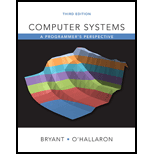
Concept explainers
A)
Given Information:
The given code is:
//variable declaration
//matrix
Int x[2][128];
int i;
//variable to store sum
Int sum=0;
//iterate through the matrix
for(i=0;i<128;i++)
{
//sum of matrix elements
sum+= x[0][i]*x[1][i];
}
Explanation:
- The given array is x[2][128]. The cache is initially empty and it begins to store data from “0x0” addresses.
- Here, size of (int) =4.
- Only memory accesses entries of array “x”.
- C arrays allocated in row-major order which means that each row is in their contiguous memory location.
B)
Given Information:
The given code is:
//variable declaration
//matrix
int x[2][128];
int i;
//variable to store sum
int sum=0;
//iterate through the matrix
for(i=0;i<128;i++)
{
//sum of matrix elements
sum+= x[0][i]*x[1][i];
}
Explanation:
- The given array is x[2][128]. The cache is initially empty and it begins to store data from “0x0” addresses.
- Here, size of (int) =4.
- Only memory accesses entries of array “x”.
- C arrays allocated in row-major order which means that each row is in their contiguous memory location.
C)
Given Information:
The given code is:
//variable declaration
//matrix
Int x[2][128];
int i;
//variable to store sum
Int sum=0;
//iterate through the matrix
for(i=0;i<128;i++)
{
//sum of matrix elements
sum+= x[0][i]*x[1][i];
}
Explanation:
- The given array is x[2][128]. The cache is initially empty and it begins to store data from “0x0” addresses.
- Here, size of (int) =4.
- Only memory accesses entries of array “x”.
- C arrays allocated in row-major order which means that each row is in their contiguous memory location.
D)
Given Information:
The given code is:
//variable declaration
//matrix
int x[2][128];
int i;
//variable to store sum
int sum=0;
//iterate through the matrix
for(i=0;i<128;i++)
{
//sum of matrix elements
sum+= x[0][i]*x[1][i];
}
- The given array is x[2][128]. The cache is initially empty and it begins to store data from “0x0” addresses.
- Here, size of (int) =4.
- Only memory accesses entries of array “x”.
- C arrays allocated in row-major order which means that each row is in their contiguous memory location.
E)
Given Information:
The given code is:
The given code is:
//variable declaration
//matrix
Int x[2][128];
int i;
//variable to store sum
Int sum=0;
//iterate through the matrix
for(i=0;i<128;i++)
{
//sum of matrix elements
sum+= x[0][i]*x[1][i];
}
Explanation:
- The given array is x[2][128]. The cache is initially empty and it begins to store data from “0x0” addresses.
- Here, size of (int) =4.
- Only memory accesses entries of array “x”.
- C arrays allocated in row-major order which means that each row is in their contiguous memory location.
Want to see the full answer?
Check out a sample textbook solution
Chapter 6 Solutions
Computer Systems: A Programmer's Perspective (3rd Edition)
- Please solve and answer the questions correctly please. Thank you!!arrow_forwardConsidering the TM example of binary sum ( see attached)do the step-by-step of execution for the binary numbers 1101 and 11. Feel free to use the Formal Language Editor Tool to execute it; Write it down the current state of the tape (including the head position) and indicate the current state of the TM at each step.arrow_forwardI need help on inculding additonal code where I can can do the opposite code of MatLab, where the function of t that I enter becomes the result of F(t), in other words, turning the time-domain f(t) into the frequency-domain function F(s):arrow_forward
 Microsoft Visual C#Computer ScienceISBN:9781337102100Author:Joyce, Farrell.Publisher:Cengage Learning,
Microsoft Visual C#Computer ScienceISBN:9781337102100Author:Joyce, Farrell.Publisher:Cengage Learning, Systems ArchitectureComputer ScienceISBN:9781305080195Author:Stephen D. BurdPublisher:Cengage Learning
Systems ArchitectureComputer ScienceISBN:9781305080195Author:Stephen D. BurdPublisher:Cengage Learning C++ Programming: From Problem Analysis to Program...Computer ScienceISBN:9781337102087Author:D. S. MalikPublisher:Cengage Learning
C++ Programming: From Problem Analysis to Program...Computer ScienceISBN:9781337102087Author:D. S. MalikPublisher:Cengage Learning C++ for Engineers and ScientistsComputer ScienceISBN:9781133187844Author:Bronson, Gary J.Publisher:Course Technology Ptr
C++ for Engineers and ScientistsComputer ScienceISBN:9781133187844Author:Bronson, Gary J.Publisher:Course Technology Ptr EBK JAVA PROGRAMMINGComputer ScienceISBN:9781337671385Author:FARRELLPublisher:CENGAGE LEARNING - CONSIGNMENT
EBK JAVA PROGRAMMINGComputer ScienceISBN:9781337671385Author:FARRELLPublisher:CENGAGE LEARNING - CONSIGNMENT New Perspectives on HTML5, CSS3, and JavaScriptComputer ScienceISBN:9781305503922Author:Patrick M. CareyPublisher:Cengage Learning
New Perspectives on HTML5, CSS3, and JavaScriptComputer ScienceISBN:9781305503922Author:Patrick M. CareyPublisher:Cengage Learning





